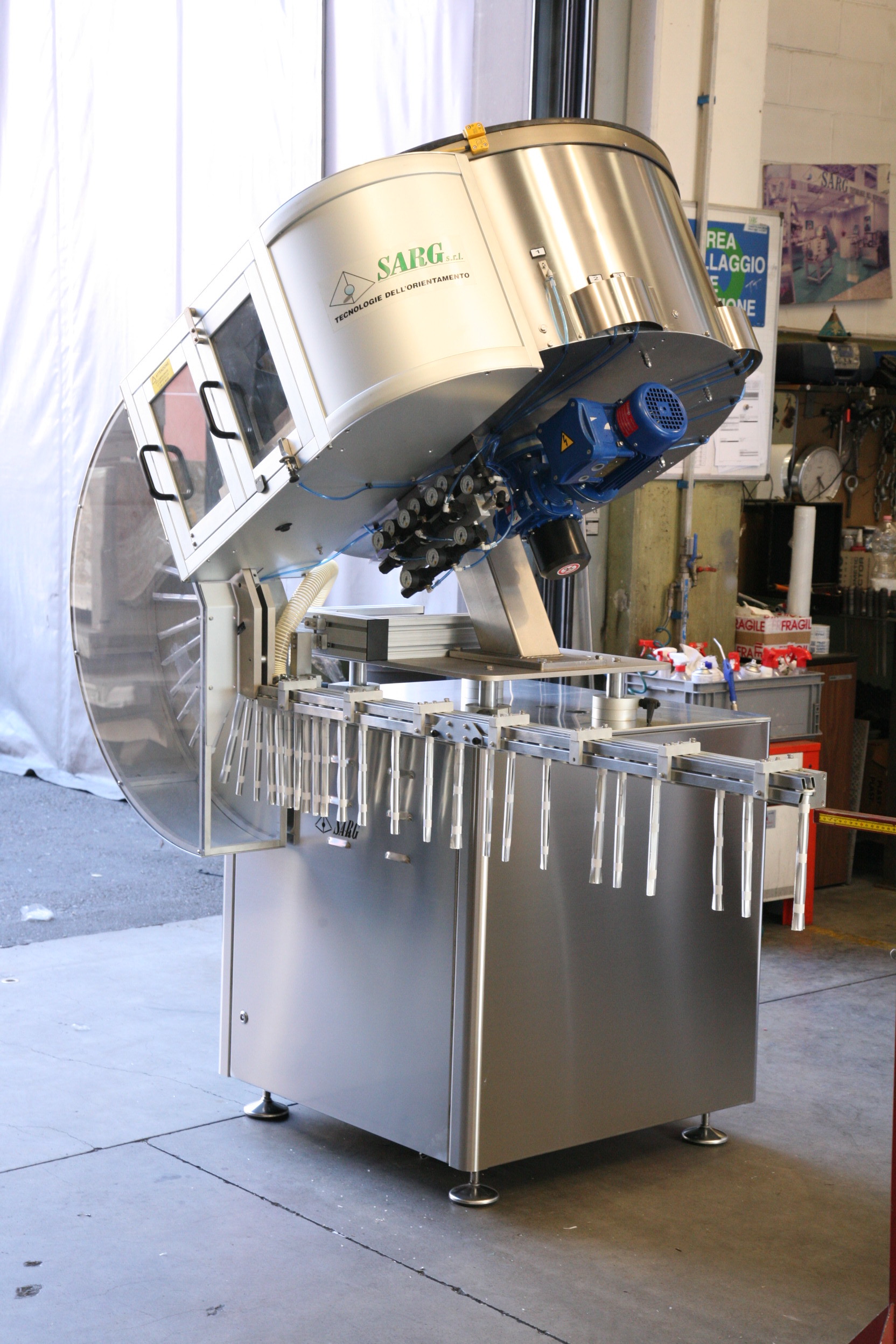How an aerosol therapy machine is made: SARG’s part orientation solutions
An aerosol machine or aerosol spray is designed and manufactured to be easily used. They allow specific medical drugs to be inhaled through normal breathing and, like all medical devices, require the utmost care during their production. The aerosol machine and spray dispensers such as aerosol inhalers (MDIs) turn the drug into small droplets by nebulizing the medical solution and allowing easy absorption through the respiratory tract.
How is an aerosol device made? First, you introduce the medical drug in the nebulization ampule, which can be manufactured in plastic, aluminum, steel, or glass. The aerosol therapy device includes a compressor that generates the flow of air. The flow of air then reaches the ampule where the drug is present through a plastic tube. The drug is sucked from the ampule by a negative pressure that is generated by the airflow at high speed. This creates small droplets that remain in suspension and are then inhaled by the patient. The smaller the droplets, the better they are distributed over the mucous membranes of the respiratory tract. An aerosol machine not only comprises an ampule and sprayer but also a mask and mouthpiece, which are designed to prevent the drug from settling in the nose. Finally, a nasal fork may be present, which can be used for direct administration.
On the other hand, aerosol sprays or spray inhalers (pMDIs) have the advantage of nebulizing in a fraction of a section through a container or cylinder with specific nozzles and valves the same amount of drug that the aerosol device delivers in 10 to 15 minutes. Additional advantages of aerosol sprays include the comfort of being able to perform the therapy anywhere, without the need for electricity and devices, quietly and quickly.
Industrial automation plays a major role in this field, since it affects both the safety of the devices and their effectiveness, as well as the design of special tools and automatic assembly lines. Assembly and filling are efficient only if the manufacturing process is subject to constant checks and if proper attention is paid to every detail.
Aerosol therapy: the importance of the proper machine
After learning how an aerosol therapy device/spray aerosols are made and before exploring what are the best solutions for part orientation and feeding for aerosol machines, it is worth highlighting how important it is for the end consumer to also assess how the devices are manufactured and assembled when they have to purchase one of these devices.
In short, it is important to pay attention to the quality of the automation and manufacturing systems when it comes to aerosol devices. To ensure that aerosol therapy can be effective, a safe device is needed. One that is manufactured using the best and most appropriate materials and assembled with equal care. Choosing the correct machine makes it possible to obtain devices that are 100 percent effective, meaning they can carry out the prescribed therapy in the best possible way. The best aerosols make it possible to treat the lower, middle, or upper respiratory tract in a selective manner. The alveoli and bronchioles, for example, can only be reached by particles with a diameter of no more than 5 microns Choosing a device that provides this type of treatment is essential for achieving the treatment goal.
Sarg’s solutions for aerosol device assembly and filling
SARG is a reference point for parts orientation in the pharmaceutical world and personal care thanks to innovative solutions developed through years of experience and capable of meeting clients’ specific needs while ensuring a fast manufacturing turnaround. Our solutions are compact and, above all, characterized by reliability and low energy consumption. Thanks to Sarg, the entire assembly line can be served: from nebulizers to caps, BOVs (bag on valve), and dispensers in different sizes and with specific requirements. At SARG, we offer custom solutions based on more than 20 years of experience in this field, achieving high levels of quality standards, productivity and technological innovation. The solution of the vibration feeding systems for aerosols, for example, makes it possible to process different models of parts with the same format to reduce format changeover times. The vibratory system for caps, in particular, consists of a system that allows the processing of caps in different sizes. It is recommended for medium and low speeds, and it offers the possibility of processing parts of various sizes with customized format changes. The system is combined with a hopper or loading lift that changes according to the desired hours of operation in battery mode and can be equipped with a protection to limit noise.
For filling applications with dispenser valves or BOV-valves with drip pipes in various lengths, or large spray caps, SARG offers a line of specific part orientation devices and lifts designed and successfully tested for these particular components so as to ensure the constant servicing of high volume lines.
Are you interested in Sarg’s part orientation solutions in the field of pharmaceutical automation? Contact us and we will answer you promptly.
